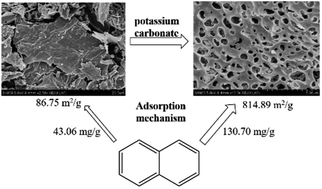Structural and adsorption characteristics of potassium carbonate activated biochar
Abstract
Potassium carbonate activated biochar (450 °C, 600 °C and 750 °C) and nonactivated biochar (600 °C) were prepared by using corn stalk as the raw material. These biochar samples were labeled as KBC450, KBC600, KBC750 and BC600. The physical and chemical properties of the biochar were strongly influenced by the activation of potassium carbonate. After activation with potassium carbonate, the aromatic, hydrophobic and non-polar properties of the biochar were enhanced to form an aromatized non-polar surface, and the aromatic properties were enhanced with the increase of the pyrolysis temperature. The outside surface of the activated biochar was similar to that of porous sponge with a mesoporous–microporous composite structure inside. The specific surface area of KBC600 was 5 times that of BC600, and KBC750 had a maximum surface area of 815 m2 g−1. Batch adsorption experiments showed that the adsorption capacity of KBC for naphthalene increased with the increase of pyrolysis temperature. The adsorption capacity of the biochar for naphthalene showed a significant positive correlation with O/C and (O + N)/C. KBC750 with the strongest surface hydrophobicity and the largest specific surface area had the largest adsorption capacity of 130.7 mg g−1. Physical adsorption and π–π EDA were the main adsorption mechanisms.



 Please wait while we load your content...
Please wait while we load your content...